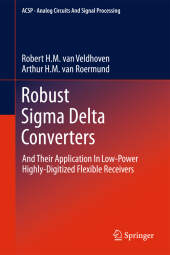 Neuerscheinungen 2013Stand: 2020-01-07 |
Schnellsuche
ISBN/Stichwort/Autor
|
Herderstraße 10
10625 Berlin
Tel.: 030 315 714 16
Fax 030 315 714 14
info@buchspektrum.de |

Arthur H. M. van Roermund, Robert H. M. van Veldhoven
(Beteiligte)
Robust Sigma Delta Converters
And Their Application in Low-Power Highly-Digitized Flexible Receivers
2013. xxiv, 296 S. 235 mm
Verlag/Jahr: SPRINGER NETHERLANDS; SPRINGER, BERLIN 2013
ISBN: 9400735235 (9400735235)
Neue ISBN: 978-9400735231 (9789400735231)
Preis und Lieferzeit: Bitte klicken
Robust Sigma-Delta Converters studies how to deal with the ever increasing requirements on IP, and how the technological advances can be exploited with the right design methodology. The book´s main objective is to explore implementation possibilities of high quality Sigma-Delta modulators.
Sigma Delta converters are a very popular choice for the A/D converter in multi-standard, mobile and cellular receivers. Key A/D converter specifications are high dynamic range, robustness, scalability, low-power and low EMI. Robust Sigma Delta Converters presents a requirement derivation of a Sigma Delta modulator applied in a receiver for cellular and connectivity, and shows trade-offs between RF and ADC. The book proposes to categorize these requirements in 5 quality indicators which can be used to qualify a system, namely accuracy, robustness, flexibility, efficiency and emission. In the book these quality indicators are used to categorize Sigma Delta converter theory. A few highlights on each of these quality indicators are;
Quality indicators: provide a means to quantify system quality.
Accuracy: introduction of new Sigma Delta Modulator architectures.
Robustness: a significant extension on clock jitter theory based on phase and error amplitude error models. Extension of the theory describing aliasing in Sigma Delta converters for different types of DACs in the feedback loop.
Flexibility: introduction of a Sigma Delta converter bandwidth scaling theory leading to very flexible Sigma Delta converters.
Efficiency: introduction of new Figure-of-Merits which better reflect performance-power trade-offs.
Emission: analysis of Sigma Delta modulators on emission is not part of the book
The quality indicators also reveal that, to exploit nowadays advanced IC technologies, things should be done as much as possible digital up to a limit where system optimization allows reducing system margins. At the end of the book Sigma Delta converter implementations are shown which are digitized on application-, architecture-, circuit- and layout-level.
Robust Sigma Delta Converters is written under the assumption that the reader has some background in receivers and in A/D conversion.


